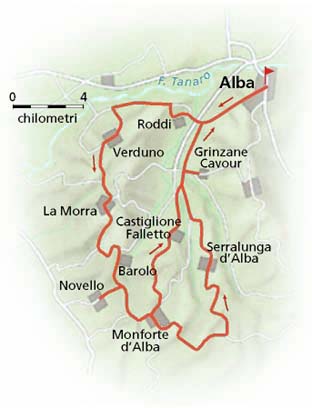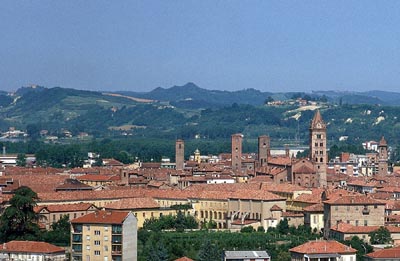Langhe, Alba and Barolo
 The hills of the Langhe district south of Alba sketch out a helter-skelter route, uphill, downhill, and round the bends that form the boundaries of Piedmont’s finest vineyards. This is the kingdom of Barolo: wine of kings, king of wines. Not that other important wines are lacking; Nebbiolo, Dolcetto and Barbera, for example. Within the space of just a few kilometres the route takes in all the most famous towns and hamlets of the area, from Barolo itself to La Morra, from Monforte to Serralunga d’Alba, in a succession of ancient estates and mediaeval towers hidden in a succession of fields and vineyards.
The hills of the Langhe district south of Alba sketch out a helter-skelter route, uphill, downhill, and round the bends that form the boundaries of Piedmont’s finest vineyards. This is the kingdom of Barolo: wine of kings, king of wines. Not that other important wines are lacking; Nebbiolo, Dolcetto and Barbera, for example. Within the space of just a few kilometres the route takes in all the most famous towns and hamlets of the area, from Barolo itself to La Morra, from Monforte to Serralunga d’Alba, in a succession of ancient estates and mediaeval towers hidden in a succession of fields and vineyards.

Alba
 The town of truffles, wine, Italian torrone nougat, and other culinary delights, lies in a little hollow in the lee of the Basse Langhe hills. Alba was founded by the ancient Ligurian peoples and populated by the Gauls and the Romans. In the Middle Ages, it became a feudal domain which was important and therefore fought over. The old centre is surrounded by Roman walls and the towers of fortified houses built in the Middle Ages as protection for the wealthier families can be seen still looming above the narrow streets. The Gothic duomo, dedicated to St Lawrence, was built in the 15th c. on the site of an early church dating from the Roman period and altered on several occasions (the facade, except for the old doorways, dates from 1878. The town’s medieval past is re-evoked every year with the costumed processions of the ‘Palio degli Asini’ (Donkey Derby) and the ‘Giostra delle cento torri’ (Tournament of the Hundred Towers) in October. The ‘Fiera Nazionale del Tartufo’ (National Truffle Fair) is held at around the same time.
The town of truffles, wine, Italian torrone nougat, and other culinary delights, lies in a little hollow in the lee of the Basse Langhe hills. Alba was founded by the ancient Ligurian peoples and populated by the Gauls and the Romans. In the Middle Ages, it became a feudal domain which was important and therefore fought over. The old centre is surrounded by Roman walls and the towers of fortified houses built in the Middle Ages as protection for the wealthier families can be seen still looming above the narrow streets. The Gothic duomo, dedicated to St Lawrence, was built in the 15th c. on the site of an early church dating from the Roman period and altered on several occasions (the facade, except for the old doorways, dates from 1878. The town’s medieval past is re-evoked every year with the costumed processions of the ‘Palio degli Asini’ (Donkey Derby) and the ‘Giostra delle cento torri’ (Tournament of the Hundred Towers) in October. The ‘Fiera Nazionale del Tartufo’ (National Truffle Fair) is held at around the same time.
Barolo
The place which embodies the essence of one of the noblest wines in Piedmont is set in the ever-changing hilly country of the Langhe. Barolo was a feudal domain of the Counts Falletti from 1480 onwards and then passed into the hands of the Gonzaga family and that of the House of Savoy. This small town with its old houses and narrow streets is at the heart of Barolo wine production. Barolo is a wine made from the red, intense Nebbiolo grape, and is intended for ageing. The town is overlooked by the Castello Falletti, which was renovated in the early 19th c. and now houses the municipal Enoteca, a kind of wine exhibition gallery containing wines from all the wine-producers of the area. In the same palazzo is the Museo della Civiltà Contadina with its collection of old objects and equipment illustrating the history and everyday life of peasant culture.
Grinzane Cavour
In this town in the Langhe hills, Camille Benso, Count of Cavour spent his youth. The Castello di Grinzane, one of the oldest castles in the area, is a majestic brick building which dates from the 13th c.; it was sumptuously renovated in the 17th c. and enhanced by the addition of small side-towers and a square keep. During the 19th c., the castle became one of the favourite residences of the Count of Cavour; nowadays, its rooms house the regional Enoteca, a sort of wine exhibition gallery specialising in the history of wine production in the Langhe hills. Every year at Grinzane the literary ‘Grinzane Cavour’ prize is awarded.
|
THE PLEASURES OF THE TABLE |
|
| Tartufo d'Alba | Robiola di Roccaverano |
| Much more than a local product, the Alba truffle, the famous Tuber magnatum pico, is one of Nature’s most wonderful gifts - the rare, unusual and extraordinary symbol of a rich gastronomic tradition. UseThe white truffle of Alba is used with respect -never, for example, with food that is too highly flavoured, because that would mask its precious characteristics. In the Langhe it is served as an antipasto simply on little squares of buttered wholemeal bread, or shaved on plates of tajarin or agnolotti pasta dressed only with butter and Parmesan. Excellent on fried eggs. | The most famous of Piedmont’s numerous robiola cheeses and the only one protected with D.O.C. regulations. Takes its name from the commune of Roccaverano in the province of Asti and is produced in several other nearby communes, in the provinces of both Asti and Alessandria.PreparationOnce made exclusively from sheep’s milk, now more usually made with a base of reduced-fat cows’ milk with additions of sheep’s and goats’ milk. Formed in the shape of a disk and weighing about 300 grammes, it is left to mature for a few days only before consumption.UseThis much prized cheese can also be found conserved under oil in glass jars. |
| Tajarin | Torta di nocciole |
| The only fresh pasta that can be safely said to have a unique local origin in Piedmont comes from the Alba district of the Langhe. Thin tagliatelle-shape egg-based pasta; can be bought fresh daily, made by hand in local shops. | The hazelnut tart is a classic speciality of the patisseries in the Langhe and Roero, made from chopped hazelnuts, flour, sugar, eggs, a drop of olive oil and yeast. On all the dessert menus of local restaurants. |
| Murazzano | |
| D.O.C. (denominazione di origine quality appellation) cheese from the Cuneo province, it derives its name from the commune of Murazzano, near Dogliani, its place of origin and production. The DOC area includes more than 40 other local communes, all in the Langhe area on slopes overlooking the descent into Liguria.UseCan be eaten by itself or dressed with extra-virgin olive oil and freshly-ground black pepper. | |
|
IL VINO |
| This zone is particularly adapted to the cultivation of vineyards, the dry climate and hilly terrain are perfect for high quality production. The most prevalent grape is the Nebbiolo. The name is derived from the word "nebbia" (fog): in fact the vine produces a grape that undergoes a late maturation process when the first fog of the season settles upon the hills. This grape produces one of the best known wines of Italy, Barolo, the glory of Piedmont wines, which takes its name from it's place of origin. Created under the care of the marquis Faletti, this noble and robust wine ages particularly well: after twenty years it is still supremely drinkable. It is a red that is truly one of its kind, should be served at a temperature higher than 18° celsius, and, an interesting particular, it remains well conserved in the bottle even after its been uncorked. If you would like to prepare a lunch or dinner reminiscent of the area, click here to purchase wines carefully selected by our experts. |
|
EATING AND SLEEPING |
| Without a doubt wine is the emblem of the Langhe as is its cuisine. In fact, this is one of the regions in Italy where you can find the best cuisine and a great price-quality ratio. Every town has its characteristic Trattoria where one can choose from a vast selection of specialties and excellent wines and also have traditional courtesy. A cuisine, which follows the seasons, and where meat is the main element, found in sauces, in pasta with minced meat and of course in the second course where we mainly find boiler meat, beef stew and braised meat in red wine. The sauces have their best expression in the renowned bagna cauda. But the real main element is the truffle, which brings out every dish from the hors d’oeuvres to the second course. When in Alba, we recommend l’Osteria dell’Arco (tel. +39 0173363974), a lovely environment found in a courtyard in piazza Savona, characteristic for its hospitality, its products and its farming tradition. We recommend you try the risotto with fondue and truffles and the truffled egg, all of which should be accompanied by one of the best wines of the Langhe. When in Barolo you must go to the Locanda nel Borgo Antico (tel. +39 017356355), an enchanting restaurant isolated in the heart of the city. And where you can savor dishes prepared with love of the tradition and the history. If you intend to stay the night in La Morra, you can go to La Cascina del Monastero (tel. +39 0173509245), a farm location in the province of Annunziata. It’s an old house with antique furniture, and it’s ideal for those who love nature and the outdoors. If you prefer a more refined and elegant place to spend the night, then we recommend Villa Beccaris (tel. +39 017378158) in Monforte d’Alba: a lovely hotel created from a 16th century villa. |








